We like history. We like real history (if there is such a beast), and we like weird, invented history as well. So today’s broadcast starts with Santiago Caruso, the talented Argentinian illustrator mentioned on here before. Why? Because of Sir Edward Grey. We are greydogtales, our first new Carnacki story was Grey Dog and we’ve just completed the novella A Study in Grey. We couldn’t resist this one.
This post will go backwards. It may make more sense than our forward ones. The other day our enormous South American intelligence network (OK, mostly Diego Arandojo and Sebastian Cabrol) alerted us that Santiago Caruso had illustrated an edition of the comic Abe Sapien from Dark Horse. Abe Sapien #30 – Witchcraft and Demonology, to be precise.
As far as we know this is Caruso’s first major comics project, and it looks fabulous. Much of his main body of work is dark, even surreal, and his style really suits the comic.
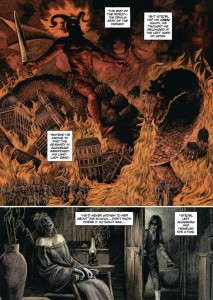
But who or what is Abe Sapien? Comics enthusiasts will know the character from Mike Mignola‘s various series concerning Hellboy, who first appeared in 1993 in a promotional short produced with John Byrne. Abe Sapien himself had his own first spin-off comics outing in 1998, in Drums of the Dead.
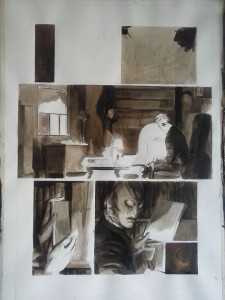
Film fans will know him, in a slightly different version, from the original 2004 Hellboy film and the sequel, Hellboy 2: The Golden Army (2008).
Abraham Sapien was born as Langdon Everett Caul, became a scientist in Victorian times, and ended up the way he is because of experiments performed on him after an encounter with an aquatic deity/monster. These occult experiments were conducted by the Oannes Society. There are two great things about this information.
The first is the old sailor’s legend that people born with a caul around their faces will never drown (the caul is part of the birth membrane, and occasionally has to be removed from the new-born). These were once prized by mariners, who thought they brought good luck and protected them from death at sea. Given that Abe Sapien is amphibious and potentially immortal, the surname Caul was well chosen.
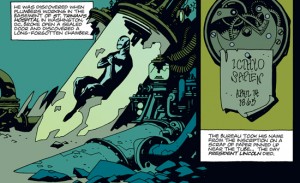
The second is that Oannes is, of course, another name for Dagon, beloved of H P Lovecraft and those who wrote after him – and a Middle-Eastern deity who had the form of both fish and man. Dagon is also the God of the Philistines in the Hebrew Bible. Oannes was supposed to rise from the waters and bring artistic and scientific gifts to mankind.
As part of Mignola’s Bureau of Paranormal Research and Defence, Abe, Hellboy and others protect America from paranormal and supernatural threats. And in that role they encounter, yes, you guessed it, Sir Edward Grey, Witchfinder. You knew it would make sense, didn’t you? No? Oh well.
We have a declared interest in characters who survive beyond their natural years through one method or another. We always loved Adam Adamant, the TV series where an Edwardian adventurer was frozen in a block of ice and thawed out in the 1960s. It had a great theme tune, too, sung by Kathy Kirby – and Juliet Harmer as Georgina Jones was gorgeous, too.
Our own Last Edwardian and erstwhile friend of Carnacki the Ghost Finder, Henry Dodgson, is still around today, but without the intervention of occultism, paranormal experiments, aliens, genetics or involuntary refrigeration.
Anyway, Sir Edward Grey. Another Victorian, like Abe, and more commonly known as the Witchfinder, Sir Edward is not only an occult detective but gifted with supernatural powers of his own. The Witchfinder comics began with the five part In the Service of Angels, written by Mike Mignola and drawn by Ben Stenbeck, published in 2009. If you don’t know this, Kim Newman, that well-known critic and author of the weird, took hold of some of the writing reins in 2014 for another five-parter, The Mysteries of Unland, written with Maura McHugh.
In short, after some occult detecting of his own, Sir Edward is asked by Queen Victoria to become a special agent of the crown, looking into the paranormal, supernatural and downright icky. He is knighted after foiling an assassination attempt on the queen, and goes on to investigate the foul activities of various warlocks, witches and vampires, becoming increasingly concerned about the plans of certain occult brotherhoods.
After leaving the queen’s service, he has his own occult detective practice in London, and is active there during the Edwardian period. We have a sneaking feeling that Sir Edward should have (and may have) met Carnacki, although their techniques would have probably had them at odds.
Unlike Carnacki, who definitively disappeared after “the incident” on Roulston Scar (that’s our story, and we’re sticking with it), the Sir Edward Grey of the comics reappears a century later. This time he seems more of a supernatural figure himself, masked, robed and mysterious with some cracking warlockian powers. In this incarnation he can be found in Hellboy in Hell, an ongoing series scripted again by Mike Mignola, with art by Dave Stewart.
But Edwardian is our game for the moment, which links to our next, slightly more real Sir Edward Grey (1862 – 1933), who was the UK’s Foreign Secretary from 1905 to 1916, – and thus in Government at the time when William Hope Hodgson was writing. He was also there when Henry Dodgson, Abigail Jessop and our other characters were carrying on the work of Cheyne Walk, of course.
Rather excitingly, our novella A Study in Grey completely fails to mention that the background of the Balkans crisis (discussed therein) would have been coloured by Sir Edward Grey’s negotiations with Russia. Sir Edward hoped that Britain, France and Russia would provide a brake to the ambitions of the Germans and the Austro-Hungarian Empire. Had we dwelt on this aspect, of course, much snoring and bored muttering would have occurred. So we left it out.
There is a chance you already know him, but probably not by name. This is the chap who stood looking out over a London evening at the outbreak of World War One and uttered the famous words:
“The lamps are going out all over Europe. We shall not see them lit again in our time.”
A Liberal politician and, we think, the longest serving Foreign Secretary in British history. Thrilling, eh? Nothing like a bit of period detail.
So who is the third Sir Edward Grey? That’s the easiest of the lot. As you will have been taught in school, Sir Edward Grey (c. 1415–1457) was the father of Sir John Grey of Groby, whose wife Elizabeth Woodville later married King Edward IV of England. Got that? There will be a test next week.

Such a lineage makes Sir Edward, yes, the great-great-great-grandfather of Lady Anne Grey, who at the age of sixteen or seventeen managed to be Queen of England for nine days.
Rather unfortunately she was executed in 1554, having done nothing wrong except being a Protestant and in the way of the Catholic “Bloody Mary”. Mary’s nickname came from her rather unpleasant habit of burning Protestant dissenters at the stake – almost 300 of them. Luckily for some, Elizabeth I came along not long after, which was extremely handy given that this was the Elizabethan Age. What are the chances, eh?
We have kept our promise. Three Sir Edward Greys, and another record for the greydogtales archives. Thank you for listening, and goodnight.
On this channel next week – a dead author or two, and lurchers. Must have lurchers…
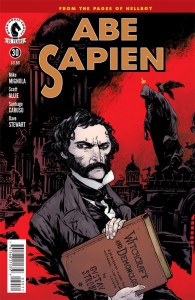
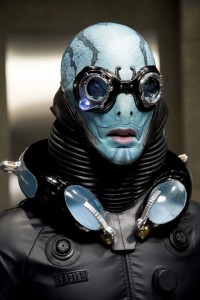


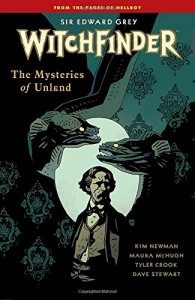
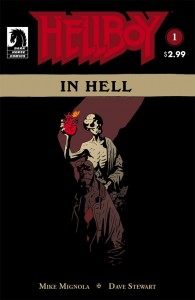
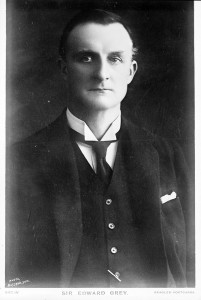
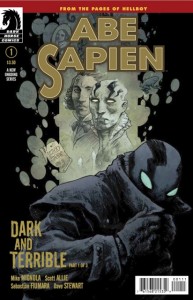
Great post!
Thanks Sebastian. If I could fill greydogtales with you and the other great Argentinian illustrators, I think I would do it!
Are you insinuating that these gentlemen are all separate individuals? I find that a little hard to[ believe.
Hi Gaia. You think that there may be only one Edward Grey, moving through centuries with a quiet agenda of his own? There should be a novel or two in that idea!